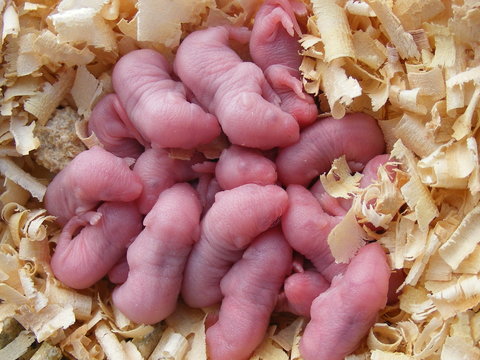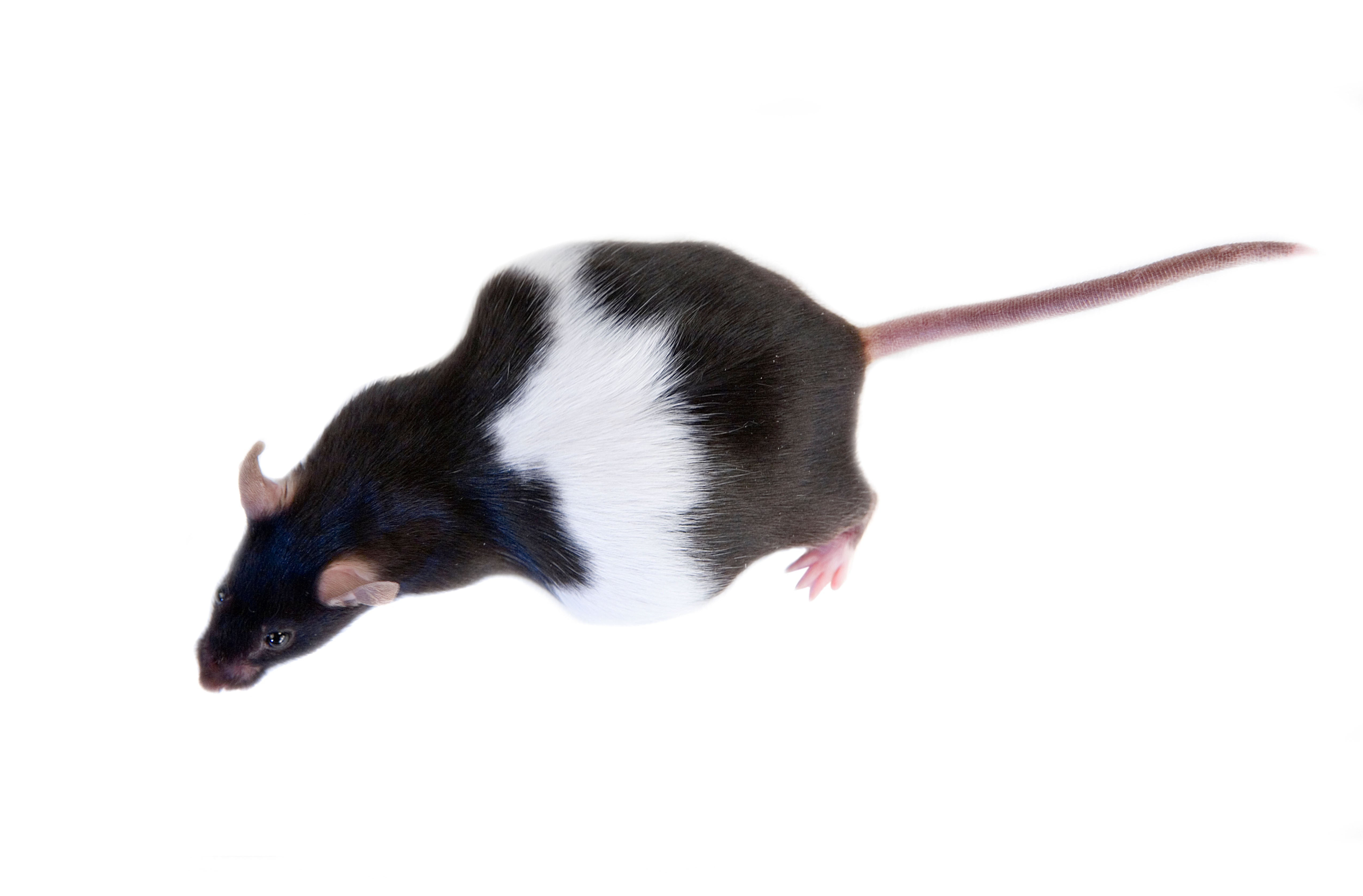- to study a specific developmental stage
- to examine and understand congenital abnormalities and embryonic lethality
- to generate primary tissue cultures
- to obtain zygotes and blastocysts for injection of DNA or modified embryonic stem cells respectively in the generation of genetically engineered models (GEM)
- to identify potential adverse effects of drugs, chemicals and other agents on fertility and fetal development in DART (developmental and reproductive toxicology) studies
Timed Pregnancies Protocol
Timed pregnancies are achieved by putting males and females together in a breeding cage in the evening, and check for signs of mating the following day. Visible evidence of a successful mating is the formation of a whitish mass in the vaginal opening of the female resulting from remnant secretions from the male. This is called a "plug" for mice or "smear" for rats. In certain strains, the plug may dissolve rapidly or fall out, so make sure to check the plug first thing in the morning.
The male can be removed from the breeding cage and the embryos are noted as being half a day old: E0.5, or dpc 0.5 (days post coitum). Be careful though: while the plug/smear indicates that the mating occurred, it does not guarantee that it was successful! Pregnancy can only be confirmed by palpation of the potentially pregnant female after at least 11 days, and can visibly be confirmed after 14 days.
Many vendors can provide you with timed pregnant females, but you can also set up timed pregnancies in your own animal room. To increase your chances, follow the 3 tips for successful timed pregnancies below.
Isolate Males and Females
Picking the right animals to start with can make a big difference (1): pick virgin females that are between 2-3 months old max, and a proven stud or older males that are around 3-4 months old. House stud males individually for at least one week prior to the mating to build up sperm count and maximize their fertility. In parallel, and especially for mice, group-house the females to synchronize their estrous cycle: due to the Lee-Boot effect, the females will go into anestrus (period of complete reproductive quiescence).
To learn more about the rodent estrus cycle, refer to our previous blog:
Breeding Mice & Rats (Part 2): How to Support Pregnancy and Pup Rearing
The day of mating, in the evening, add 1 to 2 females into each male cage. Due to the Whitten effect, exposure of the females to the males' pheromones in the cage will stimulate ovulation and results in higher rate of pregnancies.
To learn more about Lee-Boot and Whitten effect, refer to our previous blog:
Three Crazy Effects During the Mouse Estrus Cycle You Ought to Know
Avoid Stressors in Pregnant Dams
Implantation of embryos usually occurs after 4-5 days for mice and 5-6 for rats (2). However, in both mice and rats, a delayed implantation can occur. An embryos' development is temporarily suspended at the blastocyst stage and held in the uterus for up to 13 days! This interesting phenomenon is called embryonic diapause (3). This temporary arrest of embryo development is conserved in many species, including over 130 mammals (4) such as pigs, rabbits, bears, deers and sheep. It is a protective reproductive strategy, and represents an important developmental advantage for species survival (5): when conditions are hostile for pregnancy, the receptivity of the uterus is blocked. Stressful conditions are usually the cause, both in the wild and in the lab. including:
- Metabolic stress, usually due to lactation and suckling pups (6)
- Climatic stress, such as seasons, harsh climates, photoperiod (day length in the wild or light/dark cycles in the lab) and temperature
- Undernutrition or food deprivation, for example vitamin D (7) and vitamins B1 and B5 (8) deficiency
- Psychological stress and psychosocial conditions, including (in the lab) cage overcrowding, change of cage mate or isolated housing

In your studies with timed pregnancies, embryonic diapause can mean harvesting embryos or fetuses that are younger than you would expect in relation to the mating date and gestational length, and not at the age needed for your experiment, leading to a waste of animals and/or false results. Try to reduce stressors as much as possible in your colonies. Transportation/shipment of the mice during pregnancy is a high stressor; it is recommended to not ship timed pregnant females until the implantation occurs, or the pregnancy is confirmed.
To learn more about stress in the lab, and get more tips about reducing stressors when breeding your colonies, refer to some of our previous blogs:
Pain is a Variable that Affects Data Reproducibility
Cannibalism in Laboratory Rodents: Stressors to Avoid
Provide Supplements and Enrichment
As a general rule, providing extra bedding, nesting material (such as Nestlets, Cocoon, Enviropak, Crink-l’Nest, etc.) and shelter (Shepherd Shacks, Mouse House, etc.) to all your breeding cages should be a husbandry staple. Rodents are nesting animals, and nest building can even be used as an indicator of the animals' health (9). Nests provide the animals with protection from the outside (such as sounds and lights), and keep them warm, thereby reducing stress, and increasing their health, welfare and breeding outcome.
Rodents are foragers, and spend most of their time foraging for food every night in the wild. Providing foraging opportunity such as dried fruits or veggies, nuts, seeds, or grain based cereal offer a simple way to reduce stress and aggression, and improve welfare. ClearH2O's FiberBites® and VitaBites® can provide foraging opportunities while providing extra fiber or vitamins respectively. ClearH2O's DietGel® Prenatal also contains flax seeds and sunflower seeds to give the breeders another opportunity to forage in the gel.
Overall, timed pregnancies studies are not trivial, and require the careful attention of a trained lab animal caretaker, to record the breeders' pedigree, to follow pre-mating housing conditions, to document mating date and time, to check plugs or smears on the animals, and to support husbandry practices in alignment with the 3Rs with modifications and adjustments specifically tailored to breeding rodents.
How to Increase the Success of Timed Pregnancies in Mice and Rats: References
(1) 6 steps for setting up timed pregnant mice - The Jackson Laboratory
(2) Protocol for Setting Up Timed Pregnant Rats and Mice - Charles River
(3) What are timed pregnant rodent models? - Taconic
(4) The enigma of embryonic diapause
(5) Embryonic diapause in humans: time to consider?
(6) Embryonic diapause and its regulation
(7) Temperature-dependent vitamin D signaling regulates developmental trajectory associated with diapause in an annual killifish
(8) Pupal Diapause caused by Vitamin Deficiency
(9) Nest building as an indicator of health and welfare in laboratory mice




Leave a comment
All comments are moderated before being published.
This site is protected by hCaptcha and the hCaptcha Privacy Policy and Terms of Service apply.